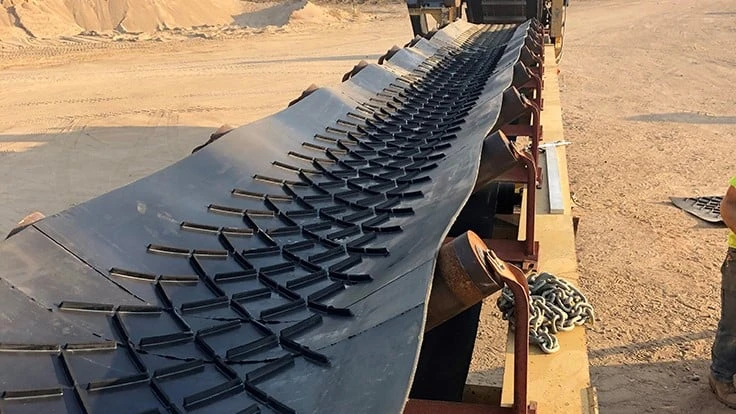
Image courtesy of WCCO Belting
Although stationary and mobile crushers are similar in the demolition and recycling materials they are used to process, they have diverse requirements when it comes to operational strategy and maintenance. The equipment design of each complements their unique environments, and key components like the conveyor belting can further optimize performance and drive uptime.
Stationary crushers are workhorses in the recycling yard that turn out long runs over long hours. These systems, permanently attached to the ground, are pushed and tested day after day for decades. These systems are used to crush materials delivered to the recycling center by the truckload from projects across the entire region. Mobile crushers, conversely, generally operate within a smaller footprint. This equipment is used for smaller volumes and offers the added luxury of mobility. This allows these mobile units to be more versatile and accommodating.
For both types of equipment, there is a general misconception that the thickest belt on the market is the best belt due to the application’s abrasive conditions, but that’s not necessarily the case. The following seven considerations can help operators of both stationary and mobile crushers make the best belt choice for their needs.
- Conveyor belting is not a “one size fits all” product: Disregarding belt specifications in favor of price might help save pennies up front, but it will cost real dollars down the road. For example, it’s hard to dispute that using a mobile crusher that’s too small for the job will fail to meet yield requirements and will, therefore, reduce profits. Similarly, a crusher that is oversized will carry additional expenses to manage, won’t add value and will add cost. This same concept holds true for belting. Thicker belts cost more money and require more resources to operate.
- Belting experts can amplify the value the belt can bring to the entire operation: Many believe conveyor belting has a singular purpose to convey material from one location to another. In reality, if a stationary plant is running multiple sorting conveyors at a variety of inclines and lengths, using the same belt for each conveyor would not optimize productivity. However, a methodical approach to determine function over cost for each conveyor will increase overall system performance.
- Conveyor length plays a large part in determining the most optimal belt design: A stationary crusher can support longer conveyor systems due to the site’s permanent structure and immobility of the stationary crusher units. A mobile unit will have much shorter runs and see increased cycles and revolutions on the conveyor belts. Conveyor length helps to determine the specification requirements and the best belt for the job, with many of the belt properties relating directly to cost.
- Rubber is heavy. How much do you really need?: Belt thickness and mass are critical in a mobile unit that has a limited power source to operate. A low-profile conveyor belt design manufactured with high-strength inputs (i.e., the rubber and fabric) will reduce energy consumption by reducing weight, excess drag, and rolling resistance.
- Belt strength comes from the fabric: The No. 1 priority for operators is to protect the integrity of the belt carcass—the rubber cover and fabric plies—for longevity. The rubber cover is the first and second line of defense to protect the strength of the belt and the fabric. The cover’s compound properties can be tailored to reduce abrasion and tearing. Following suit, custom engineering the fabric and matching a belt’s properties to the application requirements will increase performance and efficiency.
- A custom belt can be cost-effective: Building strength in one area of the belt, like tensile, isn’t the only answer to increasing belt life. Frankly, building strength in all areas of the belt isn’t the best answer either because the overdesign will backfire on equipment stamina. By defining the application and operating requirements, a belting expert can deliver a solution with the strength where it’s needed most, which can have long-lasting impacts on the overall health of the equipment.
- The right belt will reduce total cost of ownership: Users can maximize profitability with a basic understanding of belt concepts and principles, as well as a healthy relationship with a qualified belting supplier. Belting suppliers can work with customers regarding their operating requirements and build a belt with properties that improve drive uptime and the user’s bottom line.
Although the physical differences from one black rubber belt to the next are indecipherable to the untrained eye, the right belt can make or, quite literally, break one’s operation. All crushing needs are not created equal, so the belt must match the requirements of the equipment to operate effectively. Conveyor belting is one of the most costly components of a conveyor system, and sourcing the most optimal solution will more than pay for itself in the long run.
Mike Schroeder is a product specialist at Wahpeton, North Dakota-based WCCO Belting, which manufactures conveyor belts for aggregates and recycling applications.
Latest from Construction & Demolition Recycling
- US Senate backs reduced cuts to EPA
- US EPA offers brownfields-related funding
- Sky Quarry seeks crowdfunding support
- Caterpillar releases the new Cat 980 GC Wheel Loader
- NAPA leaders participate in USDOT roundtable
- Yanmar CE launches full line of compact equipment
- Metso reports increased orders after flat H1
- Block Island Recycling Management Inc. aims to promote environmental stewardship





